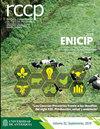以生物鱼青贮饲料(Pterygoplichthys sp.)为蛋白质来源的双用途奶牛乳品质研究
IF 0.5
4区 农林科学
Q4 AGRICULTURE, DAIRY & ANIMAL SCIENCE
引用次数: 1
摘要
背景:章鱼(Pterygoplichthys sp.)是影响水产养殖生产系统的一种有害生物。通过生物发酵,可以作为奶牛的蛋白质来源。然而,牛奶的适口性和气味可能是限制因素。目的:评价添加生物鱼青贮饲料(Pterygoplichthys sp.)作为蛋白质来源的奶牛产奶质量。方法:评价的处理(T)为T1, 0%生物鱼青贮;T2, 10%生物鱼青贮;T3, 20%生物鱼青贮。随机选择12头奶牛进行拉丁方试验设计,在三个时间段内对所有奶牛进行三种处理试验。每期20 d,其中预试期15 d,正试期5 d。对牛奶的理化、微生物、卫生状况和感官特性进行了分析。对所有响应变量进行方差分析。结果:不同处理间理化指标无显著差异。不同处理之间的微生物学和卫生变量存在差异,但其值都在高质量牛奶标准的范围内(小于10万CFU mL-1的好氧嗜温细菌,小于40万体细胞mL-1)。在感官分析中,小组成员没有在任何处理的牛奶中发现奇怪的气味,也没有发现腥味或气味。结论:生物鱼青贮可作为蛋白质源添加到哺乳期奶牛饲料中高达20%。本文章由计算机程序翻译,如有差异,请以英文原文为准。
Milk quality of dual-purpose cows supplemented with biological fish silage (Pterygoplichthys sp.) as a protein source
Background: Devilfish (Pterygoplichthys sp.) is a pest of high impact in aquaculture production systems. Through a biological fermentation process, it could be used as a source of protein for dairy cows. However, milk palatability and smell could be limiting factors. Objective: to evaluate the quality of milk from cows supplemented with biological fish silage (Pterygoplichthys sp.) as a protein source. Methods: The treatments (T) evaluated were T1, 0% biological fish silage; T2, 10% biological fish silage; and T3, 20% biological fish silage. Twelve randomly selected cows were used in a Latin square experimental design, in which three treatments were tested with all of the cows during three time periods. Each period lasted 20 days (15-day adaptation period and 5-day experimental phase). Milk was analyzed for physicochemical, microbiological, sanitary condition and sensory characteristics. Analyses of variance were performed for all the response variables. Results: No significant differences for physicochemical variables were found among the treatments studied. Differences were observed in microbiological and sanitary variables among treatments, but values were in the range for high quality milk standards (˂100,000 CFU mL-1 aerobic mesophilic bacteria, and ˂400,000 somatic cells mL-1). In the sensory analyses, panelists did not detect strange odors nor fishy taste or odor in the milk of any of the treatments. Conclusion: Biological fish silage can be included up to 20% as a protein source in supplements for lactating cows.
求助全文
通过发布文献求助,成功后即可免费获取论文全文。
去求助
来源期刊

Revista Colombiana De Ciencias Pecuarias
AGRICULTURE, DAIRY & ANIMAL SCIENCE-
CiteScore
0.80
自引率
0.00%
发文量
18
审稿时长
6-12 weeks
期刊介绍:
The editors of Revista Colombiana de Ciencias Pecuarias (RCCP) welcome the submission of original manuscripts on experimental and clinical studies associated with the broad areas of animal sciences and veterinary medicine as they interface with biochemistry, molecular biology, physiology, pharmacology, toxicology, pathology, microbiology, parasitology, immunology and epidemiology. The scope of the journal includes studies of basic and applied research in animal management and production, feeding and nutrition, reproduction, breeding, genetics, animal welfare and behavior; as well as animal production focussed from biotechnology, soil science, agrostology, silvopastoral systems, livestock economics and the environment.
The criteria for acceptance of papers submitted for publication are originality, quality and clarity of the content. Each contribution must be based on original, unpublished research that has not been simultaneously submitted to other journals. All papers will be peer reviewed. All authors bear responsibility for ensuring the integrity and quality of their reported research. It is the author''s responsibility to secure permission to use figures or tables that have been published elsewhere.
Contributions may be classified as original research, review, rapid communication, clinical case studies or methodological articles, as well as news/commentaries or letters to the editor. Most review articles are invited by the editor. Authors interested in submitting a review article should contact the corresponding editor. Rapid publication of original manuscripts is a goal of the journal. Manuscripts must be written in English. Each manuscript is considered for publication with the understanding that it has not been simultaneously submitted to any other journal. Upon acceptance for publication, papers are subject to editorial review and revision.
 求助内容:
求助内容: 应助结果提醒方式:
应助结果提醒方式:


